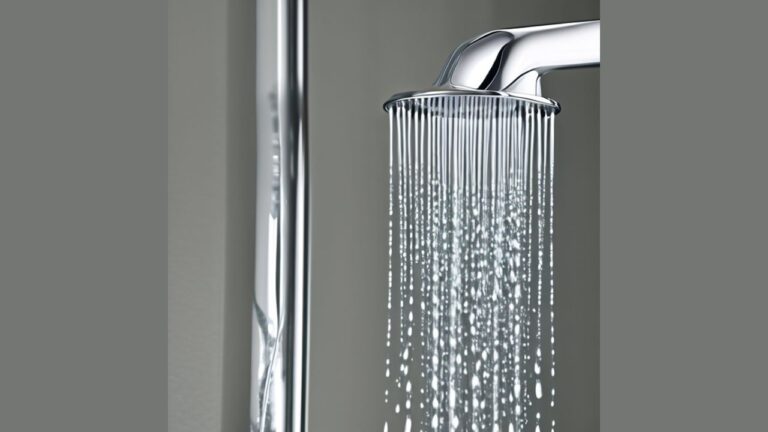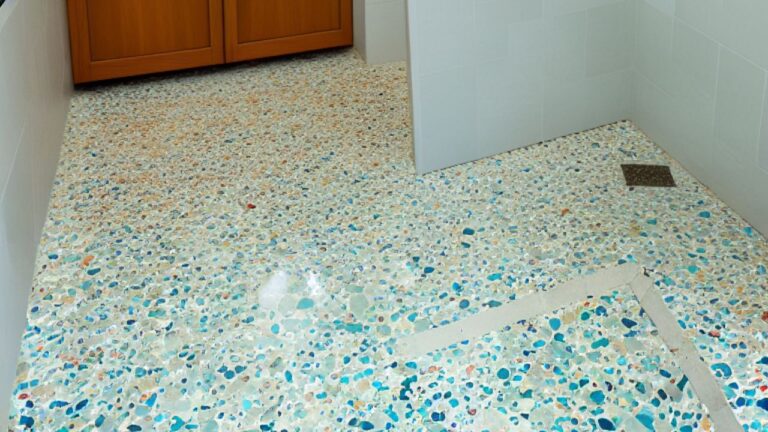If you’re looking for a flooring material that adds elegance, luxury, and sophistication to your bathroom, you might consider marble for your bathroom floors. Marble is a natural stone used in architecture and design for thousands of years. It’s known for its beauty, durability, and unique veining patterns that make each piece one of a kind. Marble is also relatively easy to maintain and can last for decades if properly cared for.
Marble is not without its drawbacks. It can be slippery when wet, expensive, prone to scratching and staining, and requires professional installation. In this article, we’ll explore the pros and cons of using marble for bathroom floors and provide some key takeaways to help you make an informed decision.
Key Takeaways
- Marble is a durable material that can withstand heavy foot traffic and moisture.
- Marble is available in various colors and patterns to suit any design style.
- Marble is relatively easy to maintain but requires regular cleaning and sealing.
- Marble can be slippery when wet, so choosing a finish that provides traction is important.
- Marble is more expensive than other flooring materials, such as ceramic tile or vinyl.
- Marble can be prone to scratching and staining if not properly cared for.
- Marble requires professional installation due to its weight and fragility.
Pros of Using Marble for Bathroom Floors
Marble is a durable material that can withstand heavy foot traffic and moisture. It’s resistant to cracks, chips, and breaks and can last decades if properly cared for. Marble is also available in various colors and patterns to suit any design style. You can choose from white, beige, gray, black, green, pink, red, brown, or any other shade that matches your bathroom decor.
Marble has unique veining patterns that add character and charm to your bathroom floors. No two pieces of marble are identical, so you can create a custom look that reflects your personality and taste. Marble is also relatively easy to maintain; it only requires regular cleaning and sealing to keep its shine and beauty.
Cons of Using Marble for Bathroom Floors
Marble is not a perfect material for bathroom floors. It has some drawbacks you should be aware of before deciding. One of the main drawbacks is that marble can be slippery when wet, posing a safety hazard in your bathroom. To avoid this, choose a honed or textured finish that provides traction and reduces the risk of slipping.
Another drawback is that marble is more expensive than other flooring materials, such as ceramic tile or vinyl. The average cost of marble flooring is $10-$20 per square foot, which can add up quickly depending on the size of your bathroom. Marble also requires professional installation due to its weight and fragility, which can increase the overall cost of your project.
It can also be prone to scratching and staining if not properly cared for. Marble is a porous material that can absorb liquids, dirt, and bacteria, which can cause discoloration and damage over time. To prevent this, seal your marble floors every 6-12 months and clean up spills immediately with a pH-neutral cleaner. You should also avoid using abrasive cleaners or scrubbers that can scratch or dull your marble floors.
Choosing the Right Finish
Choosing the right finish is important when using marble for bathroom floors. A polished finish can be slippery when wet, so choosing a honed or textured finish that provides traction and reduces the risk of slipping is important.
A honed finish is a matte finish with a smooth and soft appearance. It’s more resistant to scratches and stains than a polished finish, but it can also make the color and veining of the marble less visible.
A textured finish is a rough finish with a natural and rustic look. It’s more slip-resistant than a honed or polished finish, but it can also make the marble harder to clean and maintain. Choosing the finish that best suits your design preferences and safety needs would be best.
Here’s a table that summarizes the pros and cons of each finish:
| Finish | Pros | Cons |
|---|---|---|
| Polished | Shiny and glossy appearance | Slippery when wet |
| Enhances the color and veining of the marble | Prone to scratches and stains | |
| Easy to clean and maintain | Requires frequent sealing | |
| Honed | Smooth and soft appearance | Duller and less vibrant than polished |
| Resistant to scratches and stains | More porous and absorbent than polished | |
| Provides some traction when wet | Requires frequent sealing | |
| Textured | Natural and rustic appearance | Rough and uneven surface |
| Slip-resistant even when wet | Harder to clean and maintain | |
| Less prone to scratches and stains | May hide the beauty of the marble |
Maintaining Your Marble Floors
Maintaining your marble floors is relatively easy but requires regular cleaning and sealing. Here are some tips to keep your marble floors in good condition:
- Clean up spills immediately. Spills can cause stains and damage to your marble floors, especially if they are acidic or contain dye. Use a soft cloth or paper towel to blot up the spill, then rinse with water and dry with another cloth. Avoid rubbing or scrubbing the spill, which can spread or scratch the surface.
- Use a pH-neutral cleaner. Marble is sensitive to acidic or alkaline substances, which can etch or dull its surface. Use a pH-neutral cleaner that is specially formulated for natural stone or marble. Avoid using vinegar, lemon juice, bleach, ammonia, or other harsh chemicals that can damage your marble floors.
- Avoid abrasive cleaners or scrubbers. Abrasive cleaners or scrubbers can scratch or dull your marble floors. Use a soft cloth, sponge, or mop to clean your marble floors. Avoid using steel wool, scouring pads, or brushes that can harm your marble floors.
- Seal your marble floors every 6-12 months. Sealing your marble floors can protect them from stains, moisture, and dirt. Use a penetrating sealer that is designed for natural stone or marble. Follow the manufacturer’s instructions on how to apply and remove the sealer. Test the sealer on a small, inconspicuous area first to see how it affects the color and appearance of your marble floors.
Alternatives to Marble
Many alternatives exist if you’re not sold using marble for your bathroom floors. Here are some of the most popular ones:
Ceramic Tile:
Ceramic tile is a durable and affordable flooring material in various colors, shapes, sizes, and patterns. Ceramic tile is easy to clean and maintain and can resist water, stains, and bacteria.
Depending on the design and finish, ceramic tile can also mimic the look of natural stone, wood, or metal. However, ceramic tile can also be cold and hard underfoot and can crack or chip if dropped or hit by something heavy.
Porcelain Tile:
Porcelain tile is a type of ceramic tile that is made from finer clay and fired at higher temperatures. Porcelain tile is more dense, durable, and resistant to moisture and stains than ceramic tile. Porcelain tile can also withstand high foot traffic and temperature changes, making it ideal for bathrooms.
Porcelain tile can also come in various styles and finishes, including ones that resemble marble or other natural stones. However, porcelain tile can also be expensive, slippery when wet, and difficult to cut and install.
Vinyl Flooring:
Vinyl flooring is a synthetic material made from plastic or PVC. Vinyl flooring is one of the most budget-friendly and versatile bathroom flooring options. Vinyl flooring can come in sheets, tiles, or planks and can mimic the look of natural stone, wood, or other materials.
Vinyl flooring is easy to install, clean, and maintain and can resist water, stains, scratches, and mold. However, vinyl flooring can also fade or discolor over time, emit volatile organic compounds (VOCs) that can affect indoor air quality, and dent or tear if exposed to sharp objects or heavy furniture.
Natural Stone:
Natural stone is a broad category that includes granite, slate, travertine, limestone, sandstone, and more. Natural stone is a durable and beautiful flooring material that can add value and character to your bathroom. Natural stone can also come in various colors, textures, shapes, and sizes to suit your design preferences.
However, natural stone can also be expensive, porous, slippery when wet, and hard to maintain. Natural stone requires regular sealing and cleaning to prevent stains, scratches, and damage.
Here’s a list of some of the pros and cons of each alternative:
| Flooring Material | Pros | Cons |
|---|---|---|
| Ceramic Tile | Durable | Cold and hard |
| Affordable | Prone to cracking or chipping | |
| Easy to clean and maintain | Slippery when wet | |
| Variety of colors and patterns | ||
| Porcelain Tile | More durable than ceramic tile | Expensive |
| Resistant to moisture and stains | Slippery when wet | |
| Withstands high foot traffic and temperature changes | Difficult to cut and install | |
| Mimics the look of natural stone | ||
| Vinyl Flooring | Budget-friendly | Fades or discolors over time |
| Versatile | Emits VOCs | |
| Easy to install, clean, and maintain | Dents or tears easily | |
| Resists water, stains, scratches, and mold | ||
| Natural Stone | Durable | Expensive |
| Beautiful | Porous | |
| Adds value and character | Slippery when wet | |
| Variety of colors and textures | Hard to maintain |
Conclusion
Marble is a beautiful and durable material that can add elegance and sophistication to any bathroom. However, it’s important to weigh the pros and cons before deciding. You can decide whether marble is the right choice for your bathroom floors by considering cost, maintenance requirements, slipperiness, and alternatives.
We hope this article has helped you decide whether marble is good for your bathroom floors.
Thank you for reading, and happy flooring!


